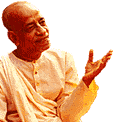Chapter 12: Devotional Service
Bg 12.1
TEXT 1
arjuna uvaca
evam satata-yukta ye
bhaktas tvam paryupasate
ye capy aksaram avyaktam
tesam ke yoga-vittamah
evam satata-yukta ye
bhaktas tvam paryupasate
ye capy aksaram avyaktam
tesam ke yoga-vittamah
SYNONYMS
arjunah uvaca—Arjuna said; evam—thus; satata—always; yuktah—engaged; ye—those; bhaktah—devotees; tvam—unto You; paryupasate—properly worship; ye—those; ca—also; api—again; aksaram—beyond the senses; avyaktam—unmanifested; tesam—of them; ke—who; yoga-vittamah—the most perfect.
TRANSLATION
Arjuna inquired: Which is considered to be more perfect: those who are properly engaged in Your devotional service, or those who worship the impersonal Brahman, the unmanifested?
PURPORT
Krsna has now explained about the personal, the impersonal and the universal and has described all kinds of devotees and yogis. Generally, the transcendentalists can be divided into two classes. One is the impersonalist, and the other is the personalist. The personalist devotee engages himself with all energy in the service of the Supreme Lord. The impersonalist engages himself not directly in the service of Krsna but in meditation on the impersonal Brahman, the unmanifested.
We find in this chapter that of the different processes for realization of the Absolute Truth, bhakti-yoga, devotional service, is the highest. If one at all desires to have the association of the Supreme Personality of Godhead, then he must take to devotional service.
Those who worship the Supreme Lord directly by devotional service are called personalists. Those who engage themselves in meditation on the impersonal Brahman are called impersonalists. Arjuna is here questioning which position is better. There are different ways to realize the Absolute Truth, but Krsna indicates in this chapter that bhakti-yoga, or devotional service to Him, is highest of all. It is the most direct, and it is the easiest means for association with the Godhead.
In the Second Chapter the Lord explains that a living entity is not the material body but is a spiritual spark, a part of the Absolute Truth. In the Seventh Chapter He speaks of the living entity as part and parcel of the supreme whole and recommends that he transfer his attention fully to the whole. In the Eighth Chapter it is stated that whoever thinks of Krsna at the moment of death is at once transferred to the spiritual sky, Krsna's abode. And at the end of the Sixth Chapter the Lord says that out of all the yogis, he who thinks of Krsna within himself is considered to be the most perfect. So throughout the Gita personal devotion to Krsna is recommended as the highest form of spiritual realization. Yet there are those who are still attracted to Krsna's impersonal brahmajyoti effulgence, which is the all-pervasive aspect of the Absolute Truth and which is unmanifest and beyond the reach of the senses. Arjuna would like to know which of these two types of transcendentalists is more perfect in knowledge. In other words, he is clarifying his own position because he is attached to the personal form of Krsna. He is not attached to the impersonal Brahman. He wants to know whether his position is secure. The impersonal manifestation, either in this material world or in the spiritual world of the Supreme Lord, is a problem for meditation. Actually, one cannot perfectly conceive of the impersonal feature of the Absolute Truth. Therefore Arjuna wants to say, "What is the use of such a waste of time?" Arjuna experienced in the Eleventh Chapter that to be attached to the personal form of Krsna is best because he could thus understand all other forms at the same time and there was no disturbance to his love for Krsna. This important question asked of Krsna by Arjuna will clarify the distinction between the impersonal and personal conceptions of the Absolute Truth.
Copyright (c) 1972 by His Divine Grace A.C. Bhaktivedanta Swami Prabhupada











